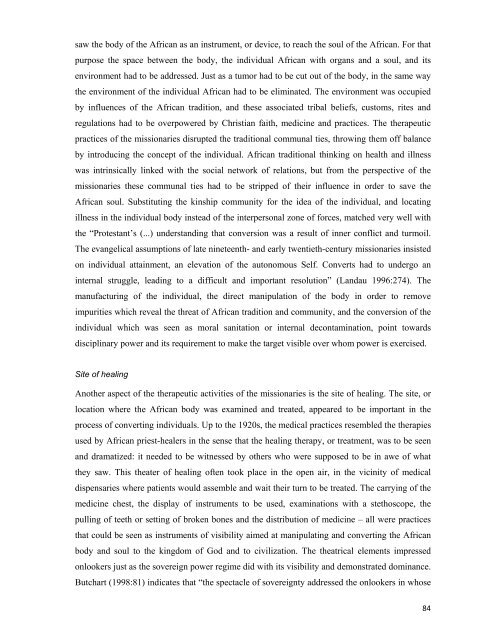spirit and healing in africa - University of the Free State
spirit and healing in africa - University of the Free State
spirit and healing in africa - University of the Free State
Create successful ePaper yourself
Turn your PDF publications into a flip-book with our unique Google optimized e-Paper software.
saw <strong>the</strong> body <strong>of</strong> <strong>the</strong> African as an <strong>in</strong>strument, or device, to reach <strong>the</strong> soul <strong>of</strong> <strong>the</strong> African. For that<br />
purpose <strong>the</strong> space between <strong>the</strong> body, <strong>the</strong> <strong>in</strong>dividual African with organs <strong>and</strong> a soul, <strong>and</strong> its<br />
environment had to be addressed. Just as a tumor had to be cut out <strong>of</strong> <strong>the</strong> body, <strong>in</strong> <strong>the</strong> same way<br />
<strong>the</strong> environment <strong>of</strong> <strong>the</strong> <strong>in</strong>dividual African had to be elim<strong>in</strong>ated. The environment was occupied<br />
by <strong>in</strong>fluences <strong>of</strong> <strong>the</strong> African tradition, <strong>and</strong> <strong>the</strong>se associated tribal beliefs, customs, rites <strong>and</strong><br />
regulations had to be overpowered by Christian faith, medic<strong>in</strong>e <strong>and</strong> practices. The <strong>the</strong>rapeutic<br />
practices <strong>of</strong> <strong>the</strong> missionaries disrupted <strong>the</strong> traditional communal ties, throw<strong>in</strong>g <strong>the</strong>m <strong>of</strong>f balance<br />
by <strong>in</strong>troduc<strong>in</strong>g <strong>the</strong> concept <strong>of</strong> <strong>the</strong> <strong>in</strong>dividual. African traditional th<strong>in</strong>k<strong>in</strong>g on health <strong>and</strong> illness<br />
was <strong>in</strong>tr<strong>in</strong>sically l<strong>in</strong>ked with <strong>the</strong> social network <strong>of</strong> relations, but from <strong>the</strong> perspective <strong>of</strong> <strong>the</strong><br />
missionaries <strong>the</strong>se communal ties had to be stripped <strong>of</strong> <strong>the</strong>ir <strong>in</strong>fluence <strong>in</strong> order to save <strong>the</strong><br />
African soul. Substitut<strong>in</strong>g <strong>the</strong> k<strong>in</strong>ship community for <strong>the</strong> idea <strong>of</strong> <strong>the</strong> <strong>in</strong>dividual, <strong>and</strong> locat<strong>in</strong>g<br />
illness <strong>in</strong> <strong>the</strong> <strong>in</strong>dividual body <strong>in</strong>stead <strong>of</strong> <strong>the</strong> <strong>in</strong>terpersonal zone <strong>of</strong> forces, matched very well with<br />
<strong>the</strong> “Protestant’s (...) underst<strong>and</strong><strong>in</strong>g that conversion was a result <strong>of</strong> <strong>in</strong>ner conflict <strong>and</strong> turmoil.<br />
The evangelical assumptions <strong>of</strong> late n<strong>in</strong>eteenth- <strong>and</strong> early twentieth-century missionaries <strong>in</strong>sisted<br />
on <strong>in</strong>dividual atta<strong>in</strong>ment, an elevation <strong>of</strong> <strong>the</strong> autonomous Self. Converts had to undergo an<br />
<strong>in</strong>ternal struggle, lead<strong>in</strong>g to a difficult <strong>and</strong> important resolution” (L<strong>and</strong>au 1996:274). The<br />
manufactur<strong>in</strong>g <strong>of</strong> <strong>the</strong> <strong>in</strong>dividual, <strong>the</strong> direct manipulation <strong>of</strong> <strong>the</strong> body <strong>in</strong> order to remove<br />
impurities which reveal <strong>the</strong> threat <strong>of</strong> African tradition <strong>and</strong> community, <strong>and</strong> <strong>the</strong> conversion <strong>of</strong> <strong>the</strong><br />
<strong>in</strong>dividual which was seen as moral sanitation or <strong>in</strong>ternal decontam<strong>in</strong>ation, po<strong>in</strong>t towards<br />
discipl<strong>in</strong>ary power <strong>and</strong> its requirement to make <strong>the</strong> target visible over whom power is exercised.<br />
Site <strong>of</strong> <strong>heal<strong>in</strong>g</strong><br />
Ano<strong>the</strong>r aspect <strong>of</strong> <strong>the</strong> <strong>the</strong>rapeutic activities <strong>of</strong> <strong>the</strong> missionaries is <strong>the</strong> site <strong>of</strong> <strong>heal<strong>in</strong>g</strong>. The site, or<br />
location where <strong>the</strong> African body was exam<strong>in</strong>ed <strong>and</strong> treated, appeared to be important <strong>in</strong> <strong>the</strong><br />
process <strong>of</strong> convert<strong>in</strong>g <strong>in</strong>dividuals. Up to <strong>the</strong> 1920s, <strong>the</strong> medical practices resembled <strong>the</strong> <strong>the</strong>rapies<br />
used by African priest-healers <strong>in</strong> <strong>the</strong> sense that <strong>the</strong> <strong>heal<strong>in</strong>g</strong> <strong>the</strong>rapy, or treatment, was to be seen<br />
<strong>and</strong> dramatized: it needed to be witnessed by o<strong>the</strong>rs who were supposed to be <strong>in</strong> awe <strong>of</strong> what<br />
<strong>the</strong>y saw. This <strong>the</strong>ater <strong>of</strong> <strong>heal<strong>in</strong>g</strong> <strong>of</strong>ten took place <strong>in</strong> <strong>the</strong> open air, <strong>in</strong> <strong>the</strong> vic<strong>in</strong>ity <strong>of</strong> medical<br />
dispensaries where patients would assemble <strong>and</strong> wait <strong>the</strong>ir turn to be treated. The carry<strong>in</strong>g <strong>of</strong> <strong>the</strong><br />
medic<strong>in</strong>e chest, <strong>the</strong> display <strong>of</strong> <strong>in</strong>struments to be used, exam<strong>in</strong>ations with a stethoscope, <strong>the</strong><br />
pull<strong>in</strong>g <strong>of</strong> teeth or sett<strong>in</strong>g <strong>of</strong> broken bones <strong>and</strong> <strong>the</strong> distribution <strong>of</strong> medic<strong>in</strong>e – all were practices<br />
that could be seen as <strong>in</strong>struments <strong>of</strong> visibility aimed at manipulat<strong>in</strong>g <strong>and</strong> convert<strong>in</strong>g <strong>the</strong> African<br />
body <strong>and</strong> soul to <strong>the</strong> k<strong>in</strong>gdom <strong>of</strong> God <strong>and</strong> to civilization. The <strong>the</strong>atrical elements impressed<br />
onlookers just as <strong>the</strong> sovereign power regime did with its visibility <strong>and</strong> demonstrated dom<strong>in</strong>ance.<br />
Butchart (1998:81) <strong>in</strong>dicates that “<strong>the</strong> spectacle <strong>of</strong> sovereignty addressed <strong>the</strong> onlookers <strong>in</strong> whose<br />
84
















